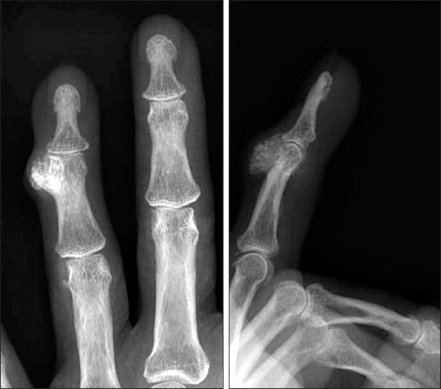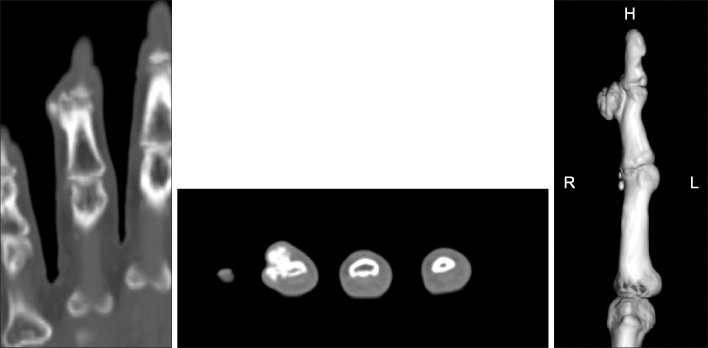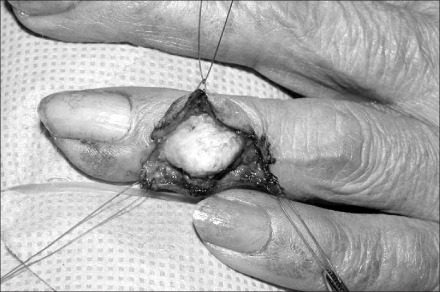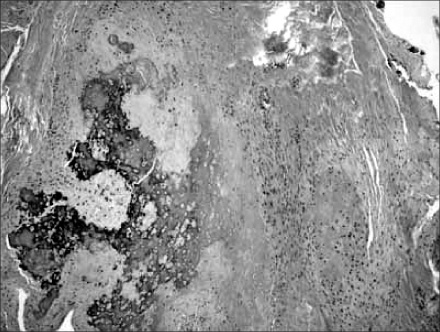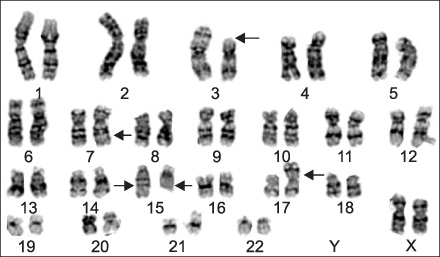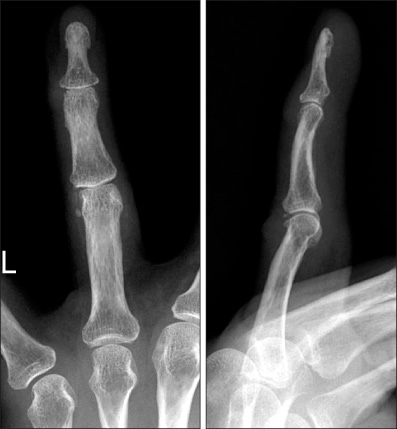J Korean Orthop Assoc.
2008 Apr;43(2):247-251. 10.4055/jkoa.2008.43.2.247.
Aberrant Chromosomal Alterations in Bizarre Parosteal Osteochondromatous Proliferation (Nora's Lesion) of Hand: A Case Report
- Affiliations
-
- 1Department of Orthopaedic Surgery, Eulji University College of Medicine, Daejeon, Korea. oskkj@eulji.ac.kr
- 2Department of Laboratory Medicine, Eulji University College of Medicine, Daejeon, Korea.
- KMID: 2106447
- DOI: http://doi.org/10.4055/jkoa.2008.43.2.247
Abstract
- Bizarre parosteal osteochondromatous proliferation is a disease similar to an osteochondroma that usually involves the metatarsal, metacarpal, proximal and middle phalanx. The symptoms are normally caused by the bone mass, the condition has a benign clinical course but recurrence is common. Recently, it was reported that there is a translocation between chromosome 1 and 17. We report a case of BPOP in the middle phalanx of hand with translocations and duplication in cytogenetic karyotyping with a review of relevant literature.
MeSH Terms
Figure
Reference
-
1. Breidahl WH, Wylie EJ. Bizarre parosteal osteochondromatous proliferation of the hands and feet. Australas Radiol. 1995. 39:401–404.2. Choi JH, Gu MJ, Kim MJ, Choi WH, Shin DS, Cho KH. Fibrosarcoma in bizarre parosteal osteochondromatous proliferation. Skeletal Radiol. 2001. 30:44–47.
Article3. Endo M, Hasegawa T, Tashiro T, et al. Bizarre parosteal osteochondromatous proliferation with a t(1;17) translocation. Virchows Arch. 2005. 447:99–102.
Article4. Kim BH, Park YK, Kim YW, Yang MH. Bizarre parosteal osteochondromatous proliferation: A report of five cases. Korean J Pathol. 1996. 30:733–738.5. Meneses MF, Unni KK, Swee RG. Bizarre parosteal osteochondromatous proliferation of bone (Nora's lesion). Am J Surg Pathol. 1993. 17:691–697.
Article6. Nilsson M, Domanski HA, Mertens F, Mandahl N. Molecular cytogenetic characterization of recurrent translocation breakpoints in bizarre parosteal osteochondromatous proliferation (Nora's lesion). Hum Pathol. 2004. 35:1063–1069.
Article7. Nora FE, Dahlin DC, Beabout JW. Bizarre parosteal osteochondromatous proliferation of hands and feet. Am J Surg Pathol. 1983. 7:245–250.8. Spjut HJ, Dorfman HD. Florid reactive periositis of the tubular bones of the hands and feet. A benign lesion which may simulate osteosarcoma. Am J Surg Pathol. 1981. 5:423–433.9. Twiston Davies CW. Bizarre parosteal osteochondromatous proliferation in the hand. A case report. J Bone Joint Surg Am. 1985. 67:648–650.
Article10. van der Walt JD, Ryan JF. Parosteal osteogenic sarcoma of the hand. Histopathology. 1990. 16:75–78.
Article
- Full Text Links
- Actions
-
Cited
- CITED
-
- Close
- Share
- Similar articles
-
- A Case of Subungual Bizarre Parosteal Osteochondromatous Proliferation of the Toe
- Bizarre Parosteal Osteochondromatous Proliferation in the First Metatarsal Bone: A Case Report
- Bizarre Parosteal Osteochondromatous Proliferation: A Report of One Case
- Parosteal Lipoma Associated with Underlying Recurrent Bizarre Parosteal Osteochondromatous Proliferation (Nora's Lesion) of the Hand
- Bizarre Parosteal Osteochondromatous Proliferation of Middle Phalanx: A Case Report


